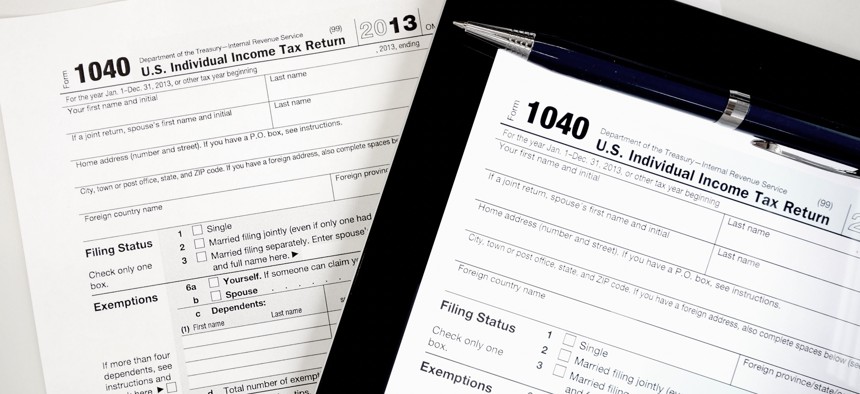On Tax Day, it’s time for a more equitable and accessible way to file

Robert Barnes / Getty Images
The IRS has the infrastructure and data in place to provide taxpayers with a free and equitable e-filing system of its own.
Every year around Tax Day, filers across the nation calculate what they owe by paying an estimated $1 billion to private filing services such as Intuit or H&R Block. These services offer convenience, but their price tags can be prohibitive to low-income filers who may get back less than what they pay for filing.
The Internal Revenue Service offers a free and direct e-file program called Free File in partnership with private tax prep companies. However, only 4.2 million returns, or 2.6 percent, were filed through Free File in 2019. Those eligible, namely those that make less than $73,000 a year, might still choose a paid service for a host of reasons, from wanting to avoid Free File’s upgrade ads to not even being aware that the option exists.
But the IRS is looking to change that. The Inflation Reduction Act of 2022 set aside $15 million for the agency to study the feasibility of a free and direct e-filing system run entirely by the federal government. Such a service could advance equity by breaking down barriers for filers, especially those who are low income or otherwise marginalized. It could also make the tax system more transparent to filers, who in 2019, left $1.5 billion in refunds unclaimed.
This isn’t the first time the IRS has looked into revamping their free and direct e-filing system. But for more than 20 years, private tax prep monoliths have spent millions lobbying against such a system.
Critics might be skeptical that the IRS is the best organization to modernize such a system. But we’ve been building user-friendly government services since our founders helped re-launch HealthCare.gov in 2013, and we’ve seen plenty of examples of large agencies successfully modernizing legacy systems. That’s why we believe that a revamped, free, human-centered direct e-filing system built and run by the IRS can help save taxpayers money and time, advance equity and help restore public trust in government services.
In order for Free File to compete with these private services, it must instill confidence among filers with a tool that offers clear application, filing status and status of refund. We’re inspired by organizations like Code for America that have envisioned what an alternative to the current filing system could look like.
The IRS is the ideal agency to revamp a free e-file system. Because of their role in the tax collection process, they already collect the data needed to launch such a service and have the infrastructure in place to register users, store tax returns and process more complicated cases. Moreover, building user-friendly, accessible programs within government institutions — as opposed to private companies — has the potential to restore trust between taxpayers and the public institutions they fund.
Experts often look to the successes and lessons of HealthCare.gov when thinking about an IRS-run filing system. We’ve worked closely with the Centers for Medicare & Medicaid Services on not only HealthCare.gov but a number of their programs, so we’re deeply familiar with the need to bring a human-centered approach to building services that reconcile the needs of the public with the policy and the law.
Human-centered design is a framework that relies on continuous user feedback to inform the development of products and services. The IRS can leverage human-centered design to build an explicit understanding of filers and civil servants, involve them in the design process, test and iterate frequently and address the user experience holistically. This will not only help the IRS build a product that saves filers time and money, but it will help them build a product that people want to use.
A critical aspect of human-centered design is user research, or the practice of testing prototypes with a diverse pool of end users. For example, when supporting the Department of Justice and 18F redesign ADA.gov, we helped pilot a program to recruit people with disabilities to test the site.
Similarly, the IRS should deeply understand the contexts and needs of tax filers — especially those from households that don’t usually file taxes, low-income filers and other marginalized populations — to maximize the efficacy of its free file program without shifting the burden to civil servants. This falls in line with the Biden administration’s executive order directing agencies to invest in customer experiences for public benefit programs in which improvements are made both for end users and civil servants who must navigate complex operations.
Such a program would also require systems that can process and transfer large amounts of data. The IRS takes in around 260 million tax returns and supplemental documents per year, and even if a user is already registered in their system, the data is mostly unique each year. Building interoperable systems that allow data to move across different parts of the agency will lead to simpler, more secure and less costly experiences for taxpayers and government agencies.
Finally, a free file program would operate at a truly massive scale, which is why the IRS should avoid a big, all-at-once launch. Instead, they should release products to smaller populations, then assess and iterate them over time. This practice is called agile development, and it relies on constant feedback, iteration and collaboration.
Human-centered design, interoperable data systems and agile development can help the IRS build a free e-file system that’s both accessible and effective. But policy and funding also need to fall into place. When the IRS releases its report on the feasibility of a free e-file system, due May 16, we’ll be well-poised to move towards actually implementing a program that just about every other country offers: an accessible, effective and free online e-filing service for all.
Jodi Leo is the Chief Delivery Officer at Nava.


